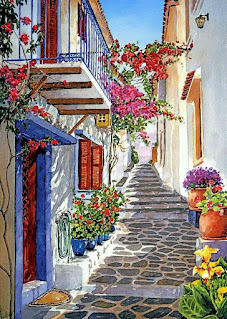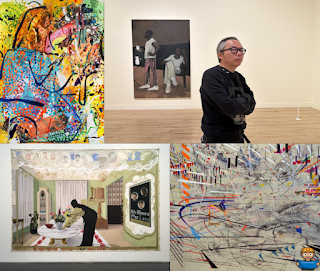Painting and sculpture are two distinct art forms that have been in existence for centuries. Painting involves the application of pigments, dyes, or other colorants to a surface such as canvas, paper, or wood, while sculpture involves the creation of three-dimensional objects from a variety of materials such as stone, wood, metal, or clay.
While both painting and sculpture have been around for a long time, there are always new forms and styles emerging within each medium. For example, in recent years, there has been a surge of interest in street art and graffiti, which often involves large-scale, colorful paintings on urban surfaces such as walls and buildings. Similarly, there has been a rise in installation art, which often incorporates sculptural elements into immersive environments that are designed to engage the viewer on multiple sensory levels.
***
*** Another new trend in painting and sculpture is the use of technology. Many artists are now using digital tools to create works that combine traditional techniques with cutting-edge technology, such as 3D printing, virtual reality, and augmented reality. These new forms of painting and sculpture allow artists to create immersive, interactive experiences that blur the line between the physical and digital worlds.
Ultimately, painting and sculpture will continue to evolve and adapt to changing cultural and technological trends, while also remaining rooted in the rich traditions and techniques that have made them such enduring art forms.
There have been many famous sculpture artists throughout history, here are some of the most well-known:
Michelangelo Buonarroti - an Italian sculptor, painter, and architect who is considered one of the greatest artists of all time. He is known for his sculptures of David and Pieta.Michelangelo Buonarroti (1475-1564) was an Italian artist who is widely regarded as one of the greatest artists of the Renaissance period. He is best known for his sculptures, paintings, and architecture.
Some of Michelangelo's most famous works include the sculpture of David, which he created between 1501 and 1504, and the frescoes on the ceiling of the Sistine Chapel in Rome, which he painted between 1508 and 1512. Other notable works include the Pietà, a sculpture of Mary holding the body of Jesus, and the dome of St. Peter's Basilica in Rome, which he designed.
Michelangelo was born in the small town of Caprese, in Tuscany, Italy. He showed an early talent for art and was apprenticed to the painter Domenico Ghirlandaio at the age of 13. Later, he studied sculpture under Bertoldo di Giovanni, a student of the famous artist Donatello.
Throughout his career, Michelangelo was known for his incredible skill and attention to detail. He was also known for his stubbornness and fiery personality, which sometimes led to conflicts with his patrons and colleagues.
Despite his many successes, Michelangelo was often unhappy with his work and frequently destroyed his own sculptures and paintings. He once famously said, "I saw the angel in the marble and carved until I set him free." This dedication to perfectionism and artistic vision has made Michelangelo a beloved and enduring figure in the history of art.
Auguste Rodin - a French sculptor who is famous for his bronze statue The Thinker, as well as many other works such as The Kiss.
Donatello - an Italian sculptor from the Renaissance period who created several famous works including his bronze David and the equestrian statue of Gattamelata.
Gian Lorenzo Bernini - an Italian sculptor and architect who is considered one of the leading figures in the Baroque style. He created many famous sculptures including Apollo and Daphne and the Ecstasy of Saint Teresa.
Alexander Calder - an American sculptor who is best known for inventing the mobile. His works are characterized by their whimsical, abstract designs.
Constantin Brancusi - a Romanian sculptor who is known for his abstract, simplified forms. His works include Bird in Space and The Kiss.
Barbara Hepworth - a British sculptor who was a leading figure in the modernist movement. Her works often incorporated organic shapes and were inspired by nature.Barbara Hepworth (1903-1975) was a British sculptor and artist known for her modernist sculptures that emphasized the organic and abstract qualities of forms. She was a leading figure in the development of British modernist sculpture in the 20th century.
Hepworth was born in Wakefield, Yorkshire, England, and studied at the Leeds School of Art and the Royal College of Art in London. Her early work was influenced by the ideas of the Dutch artist Piet Mondrian and the Russian Constructivist Naum Gabo. In the 1930s, Hepworth's style shifted towards abstraction and she began to incorporate natural materials such as stone and wood into her sculptures.
Hepworth's sculptures often featured smooth, curved forms that suggested the human body or natural objects such as rocks or waves. She frequently worked in collaboration with her second husband, the artist Ben Nicholson, and was also associated with other artists in the British modernist movement, including Henry Moore.
Hepworth's work has been exhibited extensively in galleries and museums around the world, including the Tate Gallery in London, the Museum of Modern Art in New York, and the Art Institute of Chicago. Her sculptures can also be seen in public spaces, including the United Nations headquarters in New York and the University of Liverpool.
In addition to her artistic career, Hepworth was also active in political and social causes, including the Campaign for Nuclear Disarmament and the establishment of a public art museum in St. Ives, Cornwall, where she lived and worked for many years. She was awarded the Order of Merit in 1965 and a retrospective of her work was held at the Tate Gallery in London in 1968.
Henry Moore - a British sculptor who is best known for his large-scale abstract sculptures. His works often depicted the human figure or natural forms such as rocks and bones.
These are just a few examples of the many famous sculpture artists throughout history.
The tools required for sculpture can vary depending on the type of sculpture being created, the materials used, and the individual artist's preference. However, some common tools used for sculpture include:
Chisels: used to carve and shape the sculpture's surface.
Hammers: used in conjunction with chisels to chip away at the material being sculpted.
Rasps and files: used to smooth out rough edges and create finer details.
Clay modeling tools: used for creating sculptures in clay, these tools come in a variety of shapes and sizes and are designed for manipulating and shaping the clay.
Wire tools: used for sculpting softer materials like clay and wax.
Sculpting knives: used for cutting and shaping materials like wood and stone.
Sandpaper and abrasive materials: used for smoothing out surfaces and removing rough spots.
Welding equipment: used for creating sculptures in metal.
Saws: used for cutting and shaping materials like wood and stone.
Pliers and wire cutters: used for bending and cutting wire, as well as other small tasks like attaching parts of the sculpture together.
Artist Directory:- Free registration




